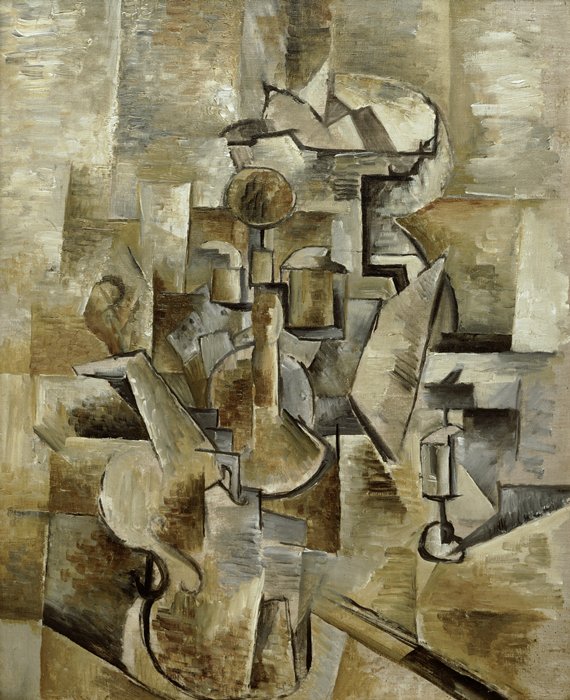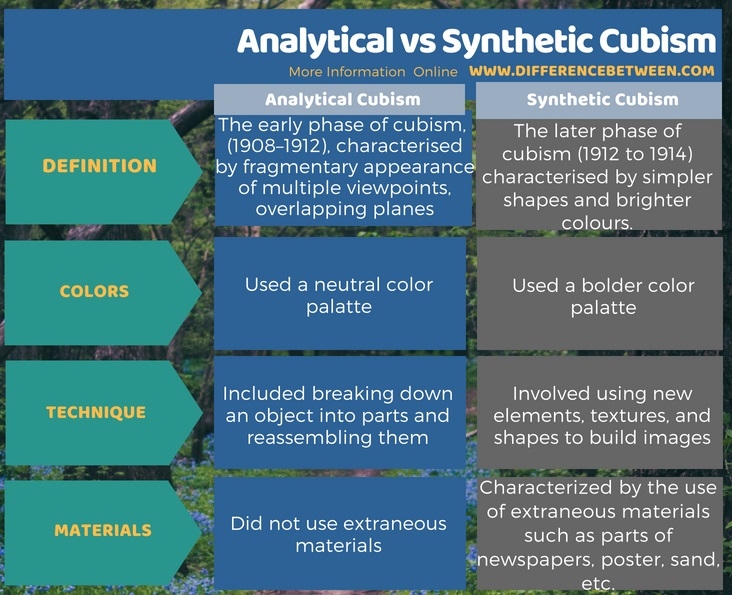The key difference between analytical and synthetic cubism is that the analytical cubism involves breaking down an object into parts and reassembling while the synthetic cubism involves using new elements, textures, and shapes to build images.
Analytical and synthetic cubism are two phases in cubism, an art movement in the early 20th century. Analytical cubism was the early phase of cubism while synthetic cubism is the later phase. As the name, ‘cubism’ implies, the objects in cubism paintings look like to be made from cubes and other geometrical shapes.
CONTENTS
1. Overview and Key Difference
2. What is Cubism
3. What is Analytical Cubism
4. What is Synthetic Cubism
5. Similarities Between Analytical and Synthetic Cubism
6. Side by Side Comparison – Analytical vs Synthetic Cubism in Tabular Form
7. Summary
What is Cubism?
Cubism is an important art movement in the early 20th century. This movement began in France in 1907 and thrived in the next two decades. Pablo Picasso and Georges Braque are considered to be the pioneers of cubism. The items in cubism artwork look like they are made out from cubes and other geometrical shapes.
Furthermore, this art style aimed to show all the possible viewpoints of a person or an object all at once. Thus, the subject matter of a painting is broken up, analyzed, and reassembled in an abstract form. Cubism also used a simple color palette in addition to simplified forms.
What is Analytical Cubism?
Analytical cubism is the earliest form of cubism, developed between 1908 and 1912. This style attempted to depict natural forms in geometric shapes like cubes, spheres, and cylinders with altered viewpoints and spatial cues. The color palate in analytical cubism was neutral with many earthy tones; this lack of color flattened the image and gave it a one-dimensional aspect. This style refers to real objects through identifiable details; through repetitive usage, these details also become signs and clues that indicate the identity of the object.

Figure 01: Violin and Pitcher by Georges Braque (1910)
For example, in the above painting, “Violin and Pitcher by Georges Braque (1910)”, we see identify specific parts of a violin. These parts represent the whole instrument as seen from different points of views.
Examples
Girl with a Mandolin by Pablo Picasso 1910
Landscape with bridge by Pablo Picasso (1909)
The Portuguese by Georges Braque (1911)
Ma Jolie by Pablo Picaso (1911)
What is Synthetic Cubism?
Synthetic cubism is a later movement in cubism, which actually grew out of analytical cubism. This movement lasted from 1912 to 1915. This style includes characteristics like simple shapes, bright colors, and little to no depth.
The most significant change in synthetic cubism is their color palatte; unlike analytical cubism, this style used bold colors like bright reds, greens, blues, and yellows, giving the paintings a greater emphasis. Moreover, this style combined a large variety of extraneous materials such as newspapers, sand, sawdust and music scores in order to add texture and pattern to art. In other words, the artists built up the image from new elements and shapes. Thus, collage, which included using signs and fragments of real things, was a main technique in synthetic cubism. The main idea behind this movement is that introducing physical elements of real life would make the paintings more ‘real’.

Figure 02: Three Musicians by Picasso
Examples
Still Life with Chair-Caning by Picasso (1911-12)
Fruit Dish and Glass by Georges Braque (1912)
The Sunblind by Juan Gris (1914)
Aria de Baq by Georges Braque (1913)
What are the Similarities Between Analytical and Synthetic Cubism?
- Analytical and synthetic cubism are phases in cubism.
- Pablo Picasso and Georges Braque were the main figures in both these movements.
What is the Difference Between Analytical and Synthetic Cubism?
Analytical cubism was the early phase of cubism while synthetic cubism is the later phase. In fact, synthetic cubism was developed from analytical cubism. While analytical cubism used a neutral color palette including earthy tones, synthetic cubism used a bolder color palette. Moreover, instead of breaking down an object into parts and reassembling them like in analytical cubism, synthetic cubism involved using new elements, textures, and shapes to build images. The two main techniques of synthetic cubism are collage and papier colles. The below infographic gives the difference between analytical and synthetic cubism in a tabular form.

Summary – Analytical vs Synthetic Cubism
Both analytical and synthetic cubism are two phases in cubism. Analytical cubism was the early phase of cubism while the synthetic cubism is the later phase. The difference between analytical and synthetic cubism depends on their use of color, patterns, and techniques.
Reference:
1.“Analytical Cubism – Art Term.” Tate, Tate. Available here
2.Gersh-Nesic, Beth. “Do You See the Clues in Analytic Cubism?” ThoughtCo. Available here
3.Gersh-Nesic, Beth. “How to Identify Synthetic Cubism.” ThoughtCo. Available here
4.“Synthetic Cubism – Art Term.” Tate, Tate. Available here
Image Courtesy:
1.’Violin and Candlestick’By Georges Braque – San Francisco Museum of Modern Art, (PD-US) via Commons Wikimedia
2.’4436739878′ by Ralph Daily (CC BY 2.0) via Flickr
ncG1vNJzZmivp6x7pbXFn5yrnZ6YsqOx07CcnqZemLyue8OinZ%2Bdopq7pLGMm5ytr5Wau26tzZqjsqyZmK6tecCnm2arqaPBqbHToppmm6WXtrS5jg%3D%3D